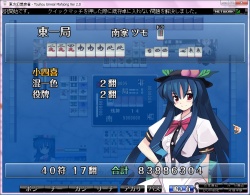Aotenjou: Difference between revisions
No edit summary |
No edit summary |
||
| Line 1: | Line 1: | ||
[[Image:Aotenjou.jpg|thumb|250px|right|Example aotenjou score.]] | [[Image:Aotenjou.jpg|thumb|250px|right|Example aotenjou score.]] | ||
'''Aotenjou''' {{kana|青天井}} is a non-standard [[Scoring|scoring system]], by which all caps and limits are removed. Per the scoring equation: | '''Aotenjou''' {{kana|青天井}} is a non-standard [[Scoring|scoring system]], by which all caps and limits are removed. Per the scoring equation, [[han]] is factored exponentially in the equation: | ||
: '''Basic points = fu × 2<sup>(2 + han)</sup>''' | : '''Basic points = fu × 2<sup>(2 + han)</sup>''' | ||
The basic points have the freedom to be valued as high as possible. Under aotenjou, scoring produces some ridiculously high numbers | Normally, the point equation has a cap applied at [[mangan]], where the basic points is artificially maxed at 2000 points. Subsequent point values are then multiples of mangan for higher scoring hands. | ||
With aotenjou, there is essentially no limit. The basic points have the freedom to be valued as high as possible, as the mangan limit is removed. Under aotenjou, scoring produces some ridiculously high numbers. Points are even much higher in conjunction with the multipliers applied for the dealer, non-dealer, and ron vs. tsumo wins. All yaku retain their original values. In additionally, [[yakuman]] patterns are defaulted at 13 han and are treated like normal yaku when determining the overall han and fu values. Furthermore, any han applied by [[dora]] counts as well to further increase the point values. | |||
Hence, for this very reason, the scoring limits imposed by both mangan and yakuman are normally used. | |||
== Extreme scoring examples == | == Extreme scoring examples == | ||
* [[Kokushi musou]] | * [[Kokushi musou]] | ||
: {{#mjt:19m19p19s1234567z}}+{{#mjt:1p}} | : {{#mjt:19m19p19s1234567z}}+{{#mjt:1p}} | ||
: This hand is then scored as 13 han 30 or 40 fu. By dealer, it is worth 7,864,400 (ron) or 1,966,080 all (tsumo). | |||
* [[Shousuushii]] + [[Tsuuiisou]] | |||
: {{#mjt:1112233777z}} {{#mjt:4'44z}} Agari: {{#mjt:2z}} or {{#mjt:3z}} | |||
[[Category:Terminology]] | [[Category:Terminology]] | ||
[[Category:Game rules]] | [[Category:Game rules]] | ||
Revision as of 01:36, 4 October 2014

Aotenjou 「青天井」 is a non-standard scoring system, by which all caps and limits are removed. Per the scoring equation, han is factored exponentially in the equation:
- Basic points = fu × 2(2 + han)
Normally, the point equation has a cap applied at mangan, where the basic points is artificially maxed at 2000 points. Subsequent point values are then multiples of mangan for higher scoring hands.
With aotenjou, there is essentially no limit. The basic points have the freedom to be valued as high as possible, as the mangan limit is removed. Under aotenjou, scoring produces some ridiculously high numbers. Points are even much higher in conjunction with the multipliers applied for the dealer, non-dealer, and ron vs. tsumo wins. All yaku retain their original values. In additionally, yakuman patterns are defaulted at 13 han and are treated like normal yaku when determining the overall han and fu values. Furthermore, any han applied by dora counts as well to further increase the point values.
Hence, for this very reason, the scoring limits imposed by both mangan and yakuman are normally used.